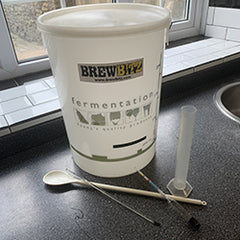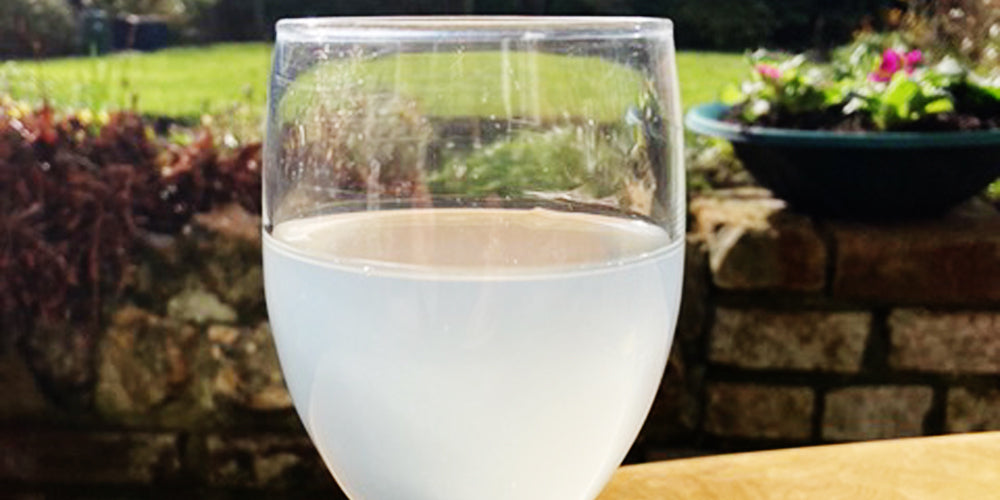Cellar 7 wine kits have been around for a few years now, and are rapidly increasing in popularity due to the excellent quality of the finished wine, and serious value for money on offer!
If you want to know how to save money on wine, that is not having to buy wine from a supermarket, then making wine at home can save you lots of serious money.
Cellar 7 wines kits are (currently) £34.95, and that will make you nearly 30 bottles. No extras ingredients are required, no bags of sugar, all you'll need are some corks, if you are going to put it into wine bottles after fermenting.
Cellar 7's come in all those familiar varieties, white wines include Chardonnay, Sauvignon Blanc and Italian White. Red varieties include Merlot, Cabernet Sauvignon and Shiraz.
Then we have rosé wines, Pinot Grigio Blush and Merlot Blush, then your fruity ones, Summer Berries and Peach & Mango, think Echo Falls...
Cellar 7 are 7 day wine kits, meaning that in just 1 week, I'll be sharing this with friends at a party, I hope they like it!

So, to find out what a bottle of wine that costs about £1.20 is like, I decided to make a Pinot Grigio. Now, I'm real busy today, but the good news is I can get this going in about 10 minutes, so I don't need to change my plans.
Day 1

Lets take a look at what is in the box, a big heavy carton grape juice concentrate and a white pack of yeast and yeast nutrient, I'll be using these today.
Then, a smaller white pack of stabiliser, and clear sachets of milky liquids, Kieselsol and Chitosan - I'll be using these later this week.
What else am I going to need today, a fermenting bucket, long plastic spoon for a bit of stirring, a hydrometer and trial jar, and a thermometer. All of this I have sterilised and we're god to go.

First, I pour the grape juice from the carton into my empty fermentation bucket, put a pint of luke warm water into the empty carton, give it a shake to get the dregs out, pour that in as well, let's get our moneys worth.

Now, I fill my bucket up with luke warm water to the 22.5l mark and give a decent stir. When done, take a quick thermometer check, I need the liquid to be between 20 and 25 degrees, so slightly warmer than room temperature.
Now I fill my trial jar up with the unfermented wine, and pop my hydrometer in, it's looking at about 1.086, which, once we've fermented out in 5 days, is going to give me a wine at about 12%. Perfect.

Next, I take my sachet of yeast and nutrient, and simply sprinkle onto the liquid, give it all another gentle stir.

Lay the lid on the bucket, I'm not going to clip it into place, and I'm going to put the bucket into my airing cupboard.

That really is it for today, how easy was that?
I'll take a look over the next few days, to see how my wine is fermenting and what is going on.
Day 3

After 78 hours, I have a really good looking frothy foamy head on my Pinot Grigio, all looks clean, and smells boozy already!
I could take a hydrometer reading, but really there is no issue here with the fermentation, and it's clearly going to carry on for a few more days yet, so not really much point. I'll just wait and see what it looks like tomorrow.
Day 5

On day 5 now, and the instructions say to take a hydrometer reading, and if we're under 1.000 then we can move on.
However, my hydrometer is showing we're not there yet, so I'm going to have to wait another day and try again.
In fact, from the image you can see little C02 bubbles in the trial jar, so we can see it's still fermenting.
Day 6

What a difference a day makes, the C02 bubbles have gone and the hydrometer is now reading about .994, prefect, let's move on.

I'm going to 'rack off' the wine, this means siphoning the wine off of the sediment into a clean bucket, so I put a sterilised bucket on the floor underneath,

and start siphoning off,

this is the left over sediment from the first bucket, you don't really want to drink this!
Before I can start clearing this wine, I need to give it a brisk stir, this will knock some of the C02 out of the liquid which will help clear the wine quicker. You'll probably get a fair bit of foam and froth on the top, which is good!

After 3 or 4 good stirs, I need to add the stabiliser to our Pinot Grigio, this will effectively kill the remaining yeast, and ensure no further fermenting takes place or anything else funny like that.

I give this a quick stir, and wait for 3 hours.

Then I add the little sachet of 'finings a', which is Kieselsol. Give it a little stir!

Another hour later, I add another sachet, this time 'finings B', which is Chitosan, and I give it another little stir.
These 2 different finings work together to quickly and efficiently clear the wine and make it as clean as a whistle. It may now look like it at the moment, but by leaving this wine now untouched for 24-48 hours, I going to have 30ish bottles of perfect, crystal clear Pinot Grigio to drink. Yum.
Day 8
The last day of making this wine kit, it took an extra day to finish fermenting properly, but I'm not too bothered about that! A bit to do today, probably it'll take me a few hours.

I can now see the bottom of my bucket, which is a good sign. So, first thing to do today is 'rack off' again, so I'm going to siphon this wine into a clean bucket, leaving the sediment that has built up during clearing behind.

After this, I do an OPTIONAL step, I'm going to run the wine through a Harris Filter, it'll take me an extra half hour or so.
Why? Well, the wine, although it is clear, will still have microscopic yeast particles and other sediment that will affect both the aroma and flavour of my finished wine.

A bit like filtered water, if you've used a Britta filter before, they remove and unwanted acids, flavours and particles to give a more refreshing drink.

The filtered wine is on the right, you can see it looks brighter, cleaner and sharper, and also the unfiltered wine has a slight yeasty kinda smell.
I filtered the wine into my bottling bucket, this has a tap at the bottom, and I've fitted a 'Little Bottle', which is a really useful bit of kit that lets me quickly and easily fill my bottles.

I've washed and sterilised 30 clear glass wine bottles, so I'm ready to go.

now for the corks,

and the finishing touches never end, I've designed some labels that I've printed, and put some white Shrink Capsules on them as well!

I think they look very smart, you probably pay £6-7 for them in a supermarket, and my Cellar 7 bottles of Pinot Grigio cost under £1.50!
They are ready to drink now, but if I can be tempted to leave them lying down in a cool garage will improve them a fair bit, maybe 2-3 months, and then they'll be at their best for 6 months or so.
Cellar 7 wine kits are very easy to make, that was really only about 6-7 steps, and if I don't want to filter then that's fine - or even bottle, I could put the wine into a Vinotainer, a large 'bag in box' for wine.
A really good starting point for you if you want to make at home and save loads of money as well!






